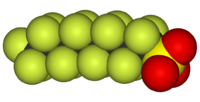
Photo from wikipedia
Perfluoroalkyl substances, such as perfluorooctanoic acid (PFOA), are widely used in consumer and industrial applications. Human epidemiologic and animal studies suggest that PFOA exposure elicits adverse effects on the pancreas;… Click to show full abstract
Perfluoroalkyl substances, such as perfluorooctanoic acid (PFOA), are widely used in consumer and industrial applications. Human epidemiologic and animal studies suggest that PFOA exposure elicits adverse effects on the pancreas; however, little is known about the biological effects of PFOA in this organ. In this study, we show that PFOA treatment of mouse pancreatic acinar cells results in endoplasmic reticulum (ER) stress and activation of the protein kinase‐like endoplasmic reticulum kinase (PERK), inositol‐requiring kinase/endonuclease 1α (IRE1α), and activating transcription factor 6 arms of the unfolded protein response (UPR) pathway. PFOA‐stimulated activation of the UPR was blocked by pretreatment with specific PERK and IRE1α inhibitors and the chemical chaperone 4‐phenyl butyrate, but not the antioxidants N‐acetyl‐ l‐cysteine and Tiron. PFOA treatment led to increased cytosolic Ca+2 levels and induction of the UPR was blocked by an inhibitor of the inositol 1,4,5‐trisphosphate receptor. These findings indicate that PFOA‐induced ER stress may be the mechanistic trigger leading to oxidative stress in the pancreas.
Journal Title: Journal of Biochemical and Molecular Toxicology
Year Published: 2020
Link to full text (if available)
Share on Social Media: Sign Up to like & get
recommendations!